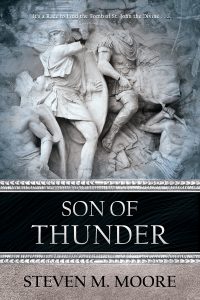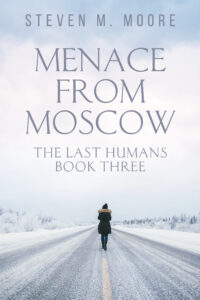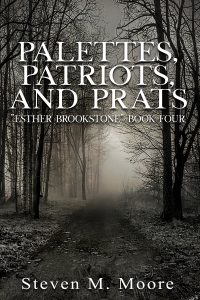Mixing reality with fiction…
Tom Clancy once stated that fiction had to seem real. Even good sci-fi needs to follow that rule in the sense that future humans should seem real and doing real things that are possible in whatever future settings are part of the plot. In a fictional universe of the past or in the near present, what better way to make things seem real than to mix the fiction with reality? Real events, real people, and real settings liberally mixed into a tale can help the reader enjoy the story more.
I’ve been boldly doing a lot more of that lately. I’m sure that I’d never get away with it if my recent novels were traditionally published, which is why traditionally published books are often just fluff! But are there any legal problems associated with mixing reality with fiction?
 Certainly not with real events! It’s good to weave a story in and around them. They provide historical context, i.e., realism, that the reader can identify with, so as long as they’re historically accurate as seen by current historians, no lawsuits can occur!
Certainly not with real events! It’s good to weave a story in and around them. They provide historical context, i.e., realism, that the reader can identify with, so as long as they’re historically accurate as seen by current historians, no lawsuits can occur!
For example, I mentioned some of the gospels not included in the standard bible in my novel Son of Thunder (to the traditional publisher Penmore Press’s credit, they let me get away with that); the Catholic Church might complain…but they have no legal options. These gospels exist, and I suspect more will be discovered. The old misogynist fellows running the Church long ago (“misogynist,” to say the least, because they made the Magdalene into a prostitute) settled on only four for their purposes, not necessarily Christ’s nor their followers.
 I mentioned Putin’s World War One style incompetent invasion of Ukraine in several novels, including the recent novel, Menace from Moscow (it completes the “Mary Jo Melendez Mysteries,” a trilogy). Putin or his oligarchs might want try to sue me for that (do they even bother to read any fiction?)—let them try! I’ve mentioned the Armenian genocide in some fiction and slavery in various stories as well; Erdogan and DeSantis might want to sue me—let them try!
I mentioned Putin’s World War One style incompetent invasion of Ukraine in several novels, including the recent novel, Menace from Moscow (it completes the “Mary Jo Melendez Mysteries,” a trilogy). Putin or his oligarchs might want try to sue me for that (do they even bother to read any fiction?)—let them try! I’ve mentioned the Armenian genocide in some fiction and slavery in various stories as well; Erdogan and DeSantis might want to sue me—let them try!
All these events actually occurred! They’re real and part of real world history. Trying to prevent me from mentioning them, as some traditional publishers might prefer in order to avoid controversy, would be censorship…so maybe I’d be the one to sue!
 What about real people? I don’t have to worry about Erdogan or Putin because I don’t live in Turkey or Russia. Other real people might present problems: Authors should be careful about libel or slander. But as long as you say good things, or even neutral things, about a real person, you’re protected, although someone might wonder if you’re claiming to have met someone when you really haven’t. (Your fictional characters can, of course.)
What about real people? I don’t have to worry about Erdogan or Putin because I don’t live in Turkey or Russia. Other real people might present problems: Authors should be careful about libel or slander. But as long as you say good things, or even neutral things, about a real person, you’re protected, although someone might wonder if you’re claiming to have met someone when you really haven’t. (Your fictional characters can, of course.)
Real settings have similar problems. I can write about St. Stephen’s Green in Dublin in Palettes, Patriots, and Prats without any repercussions and even say negative things about it (I can’t remember any, and, FYI, I’ve been there, so anything I said is a real, personal observation), but I can’t negatively critique a real hotel or restaurant—they could sue me for libel or slander. An author should be neutral or positive in such cases. After all, they’re just places even fictional characters might visit as the story progresses, so they must have had some positive thoughts about them to go there.
Here’s a copyright statement (it’s one from a recent and free PDF download—hence the second sentence—but you can use it as a model for any publication); it should take care of all the lawyers (but maybe not traditional publishers?):
All rights reserved. This free PDF download may be recopied and freely distributed to family and friends as long as the copyright is respected. It may not be sold for profit to anyone or distributed in any manner on the internet from anywhere besides the author’s website, https://stevenmmoore.com.
This novella is entirely a work of fiction. Names, characters, places, products, and events are either creations of the author’s imagination, or used as historical and venue background for the stories. Any resemblance to real persons, living or dead, events, locales, or products is coincidental, with a few exceptions, but all are used in a fictional or correct historical context. No endorsement or criticism is implied in mentioning them, nor are any opinions expressed by fictional characters necessarily those of the author.
***
 Comments are always welcome. (Please follow the rules found on the “Join the Conversation” web page.)
Comments are always welcome. (Please follow the rules found on the “Join the Conversation” web page.)
Son of Thunder. Perhaps more historical fiction than mystery or thriller, this second novel in the “Esther Brookstone Art Detective” series might be considered to be Dan Brown’s The Da Vinci Code done right (because the poor bloke didn’t know he’d got the history wrong!). Three eras are visited—St. John the Divine’s, Sandro Botticelli’s, and Esther’s—but they all come together in a startling climax at the location of St. John’s tomb. (Its location is a creation of my imagination; that he probably passed on to the pearly gates in modern-day Turkey is probably true.) Like the first and third novels in the series, there’s a lot of travel going on here as Esther’s curiosity takes her far away from her native England.
Around the world and to the stars! In libris libertas!
